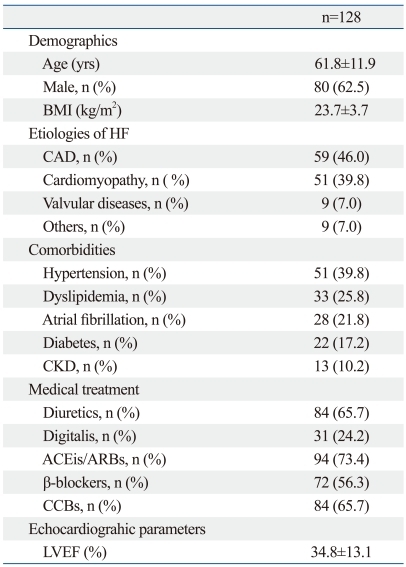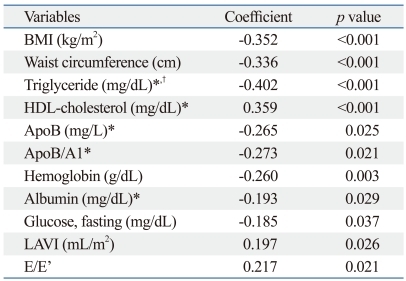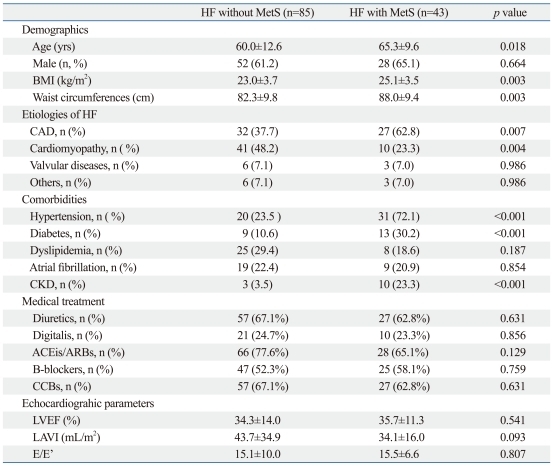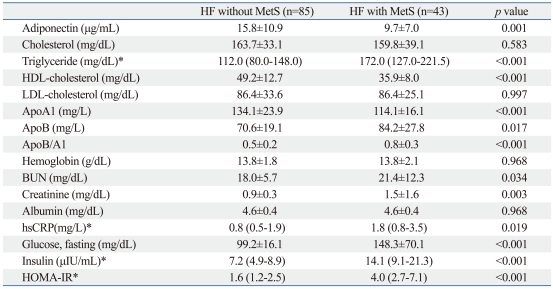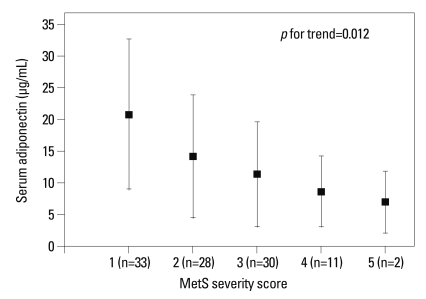Abstract
Purpose
Plasma adiponectin concentrations are inversely related with metabolic syndrome (MetS), and MetS is associated with increased risk for heart failure (HF). However, the relationship between adiponectin and MetS in HF remains undetermined. Therefore, we tested whether MetS was associated with the degree of plasma adiponectin concentrations in HF patients.
Materials and Methods
One hundred twenty eight ambulatory HF patients with left ventricular ejection fraction of <50% (80 males, 61.8±11.9 years old) were enrolled for this cross-sectional study. Echocardiographic measurements were performed, and plasma concentrations of adiponectin, lipoproteins, apolipoproteins (apoB, apoA1) and high sensitive C-reactive protein (hsCRP) were measured.
Results
Adiponectin concentrations in HF patients with MetS (n=43) were significantly lower than those without MetS (n=85) (9.7±7.0 vs. 15.8±10.9 µg/mL, p=0.001). Higher concentrations of apoB (p=0.017), apoB/A1 ratio (p<0.001), blood urea nitrogen (p=0.034), creatinine (p=0.003), and fasting insulin (p=0.004) were observed in HF patients with MetS compared with those without MetS. In HF patients with MetS, adiponectin concentrations were negatively correlated with hsCRP (r=-0.388, p=0.015) and positively correlated with the ratio of early mitral inflow velocity to early diastolic mitral annular velocity, E/E' (r=0.399, p=0.015). There was a significant trend towards decreased adiponectin concentrations with an increasing number of components of MetS (p for trend=0.012).
Conclusion
Our study demonstrated that adiponectin concentrations decreased in HF patients with MetS, and that relationship between adiponectin, inflammation and abnormal diastolic function, possibly leading to the progression of HF.
Keywords: Adiponectin, metabolic syndrome, heart failure
INTRODUCTION
Adiponectin, an adipocyte-derived cytokine, has been shown to decrease in obesity1 and in patients with type 2 diabetes mellitus.2 Furthermore, adiponectin concentrations correlate negatively with C reactive protein (CRP), interleukin 6 and tumor necrosis factor-α.3,4 Decreased adiponectin concentrations are also related to the presence of coronary artery disease5,6 and hypertension.7 Therefore, adiponectin has been suggested to have anti-inflammatory, anti-diabetic and anti-atherogenic effects. However, adiponectin concentrations are paradoxically high in patients with heart failure (HF).8-10 Moreover, high circulating concentrations of adiponectin are associated with mortality, severity and cardiac cachexia in patients with HF.11,12
Metabolic syndrome (MetS), which consists of hypertension, impaired glucose tolerance, obesity and dyslipidemia, has been reported to be associated with an increased risk of HF,13 and it is also associated with an increased risk of death in HF patients.14 To date, the relationship between adiponectin and MetS in patients with HF has not yet been investigated. Therefore, we examined to test how the degree of plasma adiponectin concentrations would be changed according to the presence of MetS in HF patients.
MATERIALS AND METHODS
Study subjects
This cross-sectional study included 128 ambulatory HF patients from the HF outpatient clinic at Severance Cardiovascular Hospital. Inclusion criteria were: 1) clinical diagnosis of HF with left ventricular ejection fraction (LVEF) <50% as documented by echocardiography, 2) age under 80 years old, and 3) stable HF on medication for at least three months before inclusion. We excluded patients with 1) diagnosis of HF with preserved ejection fraction (≥50%) and 2) diagnosis of acute myocardial infarction three months prior to inclusion. Etiology of HF, comorbidities and medications were obtained from hospital database. Chronic kidney disease was defined as an estimated glomerular filtration rate (eGFR) of less than 60 mL/min/1.73m2. The eGFR was estimated by using the simplified Modification of Diet in Renal Disease study equation.15
Patient data were collected in accordance with the institutional ethics guidelines. All patients gave written informed consent and study approval was obtained from the internal review board of Severance Hospital.
Definition of MetS
MetS was defined according to the updated National Cholesterol Education Program/Adult Treatment Panel III criteria (WHO Western Pacific Region obesity criteria) as having three or more of the following components13: 1) waist circumference ≥90 cm for men or ≥80 cm for women; 2) triglycerides ≥150 mg/dL; 3) high-density lipoprotein (HDL)-cholesterol <40 mg/dL for men or <50 mg/dL for women; 4) high blood pressure (systolic blood pressure ≥130 mm Hg or diastolic pressure ≥85 mm Hg) or current use of anti-hypertensive medications; 5) fasting glucose ≥110 mg/dL or receiving treatment for diabetes. MetS severity was scored on a scale of 1 to 5 according to the number of MetS components.
Biochemical analysis
Venous blood samples were collected from the forearm after fasting overnight for a minimum of eight hours. Serum total cholesterol and lipoproteins were measured by commercially available kits (Choongwae, Seoul, Korea). Serum triglyceride was measured with a total glycerol test kit (Roche, Basel, Switzerland). Fasting serum glucose levels were measured by using a Beckman Glucose Analyzer (Beckman Instruments, Irvine, CA, USA). Fasting serum insulin concentrations were measured with an immunoradiometric assay and a gamma counter (Hewlett Packard, Meriden, CT, USA). The plasma adiponectin was measured using an enzyme-linked immunoassay (Linco Research, St. Charles, MO, USA). The minimal detection limit for adiponectin was 0.78 µg/mL, and the intra- and interassay coefficients of variation were both <15%. Apolipoprotein (apo) A1 and apoB were measured by immunoturbidometry (Hitachi autoanalyzer, model 705, Tokyo, Japan). All other chemistries were examined by enzymatic methods using a Hitachi 7600-110, automated chemistry analyzer (Hitachi, Tokyo, Japan). The homeostasis model of insulin resistance (HOMA-IR) was calculated using the equation16; HOMA-IR=fasting insulin (µIU/mL)×fasting glucose (mg/dL)/405.
Echocardiographic measurement
Standard two-dimensional echocardiography was performed in all patients. LVEF was calculated by the modified Quinones method. Left atrial volume was calculated by the prolate ellipsoid method. The left atrial volume index (LAVI) was calculated by left atrial volume divided by body surface area. Peak velocity of early diastolic filling (E) was obtained from mitral inflow velocities by pulsed wave Doppler at apical four chamber view. Peak early diastolic velocity of mitral annulus (E') was obtained from the tissue Doppler imaging of the septal mitral annulus.
Statistical analysis
SPSS version 17.0 (SPSS Inc., Chicago, IL, USA) was used for statistical analysis. Continuous variables were described using mean±standard deviations or medians, and interquartile ranges and categorical variables were described using numbers or percentages. Triglyceride, hsCRP, insulin and HOMA-IR were logarithmically transformed for analysis. Differences in variables between the groups were evaluated using Student's t-test or the Mann-Whitney U test and using analysis of covariance (ANCOVA) for adjusting other variables. The χ2 test was used for categorical data. The correlation between adiponectin and both laboratory and echocardiographic parameters was evaluated using Spearman's correlation. ANOVA was used to compare adiponectin concentrations between groups based on the number of MetS components. A p value of <0.05 was considered statistically significant.
RESULTS
Baseline characteristics
Table 1 presents the baseline characteristics of all HF patients. This study consisted of 128 HF patients (80 of whom were male) with a mean age of 61.8±11.9 years. Most of the subjects were in New York Heart Association functional class I (47.7%) and II (52.3%). Coronary artery disease was the most common etiology of HF (46.0%). Hypertension (39.8%), dyslipidemia (25.8%), and atrial fibrillation (21.8%) were common prevalent comorbidities. Medical treatment for all subjects consisted of diuretics (65.7%), digitalis (24.2%), angiotensin converting enzyme inhibitors and/or angiotensin II receptor blockers (73.4%), β-blockers (56.3%) and calcium channel blockers (65.7%). The mean LVEF was 34.8±13.1% among all HF patients.
Table 1.
Baseline Characteristics for All HF Patients
HF, heart failure; BMI, body mass index; CAD, coronary artery disease; CKD, chronic kidney disease; ACEis, angiotension converting enzyme inhibitors; ARBs, angiotension II receptor blockers; CCBs, calcium channel blockers; LVEF, left ventricular ejection fraction.
Values are expressed as mean±SD.
Adiponectin and its correlations with variables in HF patients
Plasma adiponectin concentrations were correlated with body mass index (BMI) (r=-0.352, p<0.001), waist circumference (r=-0.336, p<0.001), triglyceride (r=-0.402, p<0.001), HDL-cholesterol (r=0.359, p<0.001), apoB (r=-0.265, p=0.025), apoB/A1 ratio (r=-0.273, p=0.021), hemoglobin (r=-0.260, p=0.003), albumin (r=-0.193, p=0.029) and fasting glucose (r=-0.185, p=0.037) (Table 2). However, no association was found between adiponectin and hsCRP, nor was adiponectin correlated with fasting insulin and HOMA-IR. Triglyceride, HDL-cholesterol, apoB, apoB/A1 ratio and albumin had significant correlations with plasma adiponectin concentrations after adjusting for age, gender, and BMI. Plasma adiponectin concentrations were significantly and positively correlated with LAVI (r=0.197, p=0.026) and E/E' (r=0.217, p=0.021), however, no significant association was found between adiponectin concentrations and LVEF.
Table 2.
Factors Correlated with Adiponectin Concentrations in All HF Patients
HF, heart failure; BMI, body mass index; HDL, high density lipoprotein; Apo, apolipoprotein; LAVI, left atrial volume index; E/E', early mitral inflow velocity to early diastolic mitral annular velocity ratio.
*Significant variables after adjustment for age, sex and BMI.
†Triglyceride was log-transformed for analysis.
Adiponectin and MetS in HF patients
Among the total 128 HF patients, 43 subjects (33.6% of total, 28 males) had MetS. As presented in Table 3, gender, medical treatment and echocardiographic parameters were similar between HF patients with and without MetS. HF patients with MetS were significantly older than HF patients without MetS. As expected, the BMIs (p=0.003) and waist circumferences (p=0.003) of HF patients with MetS were significantly higher compared with those without MetS. The proportions of the patients with coronary artery disease (p=0.007), hypertension (p<0.001), type 2 diabetes mellitus (p<0.001), and chronic kidney disease (p<0.001) were significantly higher in HF patients with MetS than in those without MetS.
Table 3.
Baseline Characteristics and Echocardiographic Parameters of HF Patients without MetS and HF Patients with MetS
HF, heart failure; BMI, body mass index; MetS, metabolic syndrome; CAD, coronary artery disease; CKD, chronic kidney disease; ACEis, angiotension converting enzyme inhibitors; ARBs, angiotension II receptor blockers; CCBs, calcium channel blockers; LVEF, left ventricular ejection fraction; LAVI, left atrial volume index; E/E', early mitral inflow velocity to early diastolic mitral annular velocity ratio.
Values are expressed as mean±SD.
We compared the concentrations of adiponectin, lipoproteins, apolipoproteins and other laboratory parameters between the two groups (Table 4). Serum concentrations of glucose, triglyceride and HDL-cholesterol were differed significantly between the two groups, while serum total cholesterol levels were similar. Concentrations of adiponectin were significantly lower in HF patients with MetS (9.7±7.0 µg/mL) than in HF patients without MetS (15.8±10.9 µg/mL) (p=0.001). Adiponectin level was also lower in HF with MetS than with HF without MetS after adjusting age and BMI in ANCOVA analysis (p=0.006). Higher concentrations of blood urea nitrogen (p=0.034), creatinine (p=0.003), hsCRP (p=0.019), fasting glucose (p<0.001), fasting insulin (p<0.001), and HOMA-IR (p<0.001) were observed in HF patients with MetS than in those without. The apoB and apoB/A1 ratio were significantly higher in HF patients with MetS than in those without MetS. Although hsCRP concentrations in HF patients with MetS were relatively higher than in those without MetS, this difference was not statistically significant (8.3±26.7 vs. 4.6±15.9 mg/L, p=0.433).
Table 4.
Laboratory Findings for HF Patients without MetS and with MetS
HF, heart failure; MetS, metabolic syndrome; HDL, high density lipoprotein; LDL, low density lipoprotein; BUN, blood urea nitrogen; hsCRP, high sensitive C-reactive protein; HOMA-IR, the homeostasis model assessment of insulin resistance.
Values are expressed as mean±SD.
*Values were expressed as median (lower quartile-upper quartile), p value from Mann-Whitney U test.
In HF patients with MetS, plasma adiponectin concentrations were correlated with waist circumference (r=-0.337, p=0.031), hemoglobin (r=-0.508, p=0.001) and E/E' (r=0.399, p=0.015) (Table 5). Fig. 1 shows the trends of adiponectin concentrations according to MetS severity score: as MetS severity scores increased, adiponectin concentrations decreased significantly in HF with MetS (p for trend=0.012).
Table 5.
Factors Correlated with Adiponectin Concentrations in HF Patients with MetS
HF, heart failure; MetS, metabolic syndrome; E/E', early mitral inflow velocity to early diastolic mitral annular velocity ratio.
Fig. 1.
Adiponectin concentrations according to MetS severity score. MetS, metabolic syndrome.
DISCUSSION
The purpose of this study was to investigate whether the presence of MetS was associated with the degree of plasma adiponectin concentrations in HF patients. We demonstrated that concentrations of adiponectin were significantly lower in HF patients with MetS than in those without MetS. Furthermore, plasma adiponectin concentrations tended to decrease in HF patients as the number of MetS components increased.
Adiponectin specifically secreted from adipose tissue is an adipokine. Adiponectin modulates glucose metabolism and insulin resistance by the 5'-adenosine monophosphate-activated kinase signaling pathway, and decreases also free fatty acid concentrations by stimulating fatty acid oxidation in muscle.16 Thus, adiponectin may act as a potential link between MetS and its cardiovascular consequences. Hypoadiponectinemia has already been shown to be associated with obesity, diabetes mellitus, insulin resistance and coronary artery disease.1,2,5,6,17-19 However, the recent literatures suggest that HF patients have significantly higher adiponectin concentrations.9,10 Although the mechanism is not clear, the possible reasons for high adiponectin concentrations in HF could be compensatory response to HF progression or adiponectin resistance.20,21 Takano, et al.22 also showed that adiponectin released from the heart may partly contribute to the increased adiponectin concentrations which are seen in the peripheral circulation of HF patients. Moreover, a high adiponectin concentration is a predictor of mortality of HF patients, independent of the risk markers of HF severity.10 Our results suggest that the presence of MetS may have an effect on the adiponectin concentration in HF patients, which implies that adiponectin may contribute to the progression of HF associated with MetS.
Plasma adiponectin concentrations are related to several clinical variables. The present study confirmed several correlations with variables including BMI, waist circumference, triglyceride, apoB, apoB/A1 ratio, and fasting glucose in HF patients. ApoB/A1 ratio has been found to be associated strongly with insulin resistance.20 Park, et al.21 demonstrated that apoB/A1 ratio was significantly correlated with adiponectin level in Koreans. In addition, Ingelsson, et al.23 reported that apoB/A1 ratio was an independent risk factor for HF. We found in the present study that adiponectin was negatively associated with apoB/A1 ratio in HF patients, even after adjustment for age, gender, and BMI.
Inflammation plays an important role in the pathogenesis and progression of HF. CRP has been found to be consistently elevated in HF and MetS patients. Our study showed that the concentrations of hsCRP were relatively higher in HF patients with MetS than in those without MetS, however, it did not reach statistical significance. It might have been due to relatively small sample size. Adiponectin has been found to correlate negatively with CRP.24 We found that hsCRP was negatively correlated with adiponectin concentrations in HF patients with MetS, although not in all HF patients.
Previous studies showed that adiponectin was correlated with cardiac geometry and function. Gustafsson, et al.25 showed that adiponectin was inversely associated with LVEF in elderly men in a community-based cohort, even after adjusting for BMI. In addition, Unno, et al.26 reported that adiponectin levels were positively associated with diastolic dysfunction in patients with hypertrophic cardiomyopathy. In the present study, no significant association was found between adiponectin concentrations and LVEF among all the HF patients and with MetS, while plasma adiponectin concentrations correlated significantly and positively with LAVI and E/E' in all HF patients. Previous study reported that adiponectin had significant correlation with LA size and volume after adjusting confounding factors, which were associated with the severity and chronicity of diastolic dysfunction. The LV diastolic dysfunction in tissue Doppler imaging (e.g. elevated E/E') presents subclinical myocardial dysfunction in general population and a better independent predictor than LVEF in systolic heart failure patients.27-30 As far as we are aware of, this is the first report about the association between adiponectin and E/E', suggesting that adiponectin could be a surrogate marker of subclinical myocardial dysfunction. Interestingly, the correlation between adiponectin and E/E' existed only in HF patients with MetS, but not in HF patients without MetS. This is consistent with recent reports that LV diastolic function and structure are associated with metabolic syndrome and insulin resistance.31
The use of β-blockers might improve metabolic profiles by improving insulin sensitivity.32,33 Yamaji, et al.34 reported that carvedilol treatment in patients with HF reduced plasma adiponectin levels and was associated with improvement of LVEF. In addition, Van Berendoncks, et al.35 showed that high adiponectin levels predicted poor outcomes in HF patients, but its prognostic value was significantly affected by β-blocker treatment. This effect of β-blocker therapy on adiponectin levels was only significant in patients with lower BMI (<30 kg/m2). In our present study, HF patients without MetS who had a relatively low BMI and were treated with β-blockers (carvedilol and bisoprolol) had significantly lower adiponectin concentrations than those not given β-blockers (data not shown).
The limitations of this study include its relatively small sample size and cross-sectional design. The cross-sectional setting of this study made it difficult to draw causality. Further studies will be warranted to investigate the effects of adiponectin on the progression of HF with MetS. Second, adiponectin concentrations have been found to increase in parallel to increases in brain natriuretic peptide (BNP) in HF patients.36 However, we were unfortunately unable to measure BNP levels in this study, therefore, we could not investigate the relationship between BNP levels and adiponectin concentrations in HF patients with or without MetS. Moreover, because all the patients had been diagnosed with systolic HF at our heart failure clinic and they were relatively non-obese, our results should be interpreted with caution. Third, weight loss and cardiac cachexia cause significant increases in circulating adiponectin concentrations.37 We had no information as to whether weight loss occurred in our HF patients.
In conclusion, we have shown that plasma adiponectin concentrations were significantly lower in HF patients with MetS than in those without MetS, and were significantly correlated with hsCRP and E/E' in HF patients with MetS. Also, there is a tendency toward decreased plasma adiponectin concentrations according to the severity score of MetS. This study implies that decreased plasma concentrations of adiponectin in HF patients with MetS are associated with inflammation and abnormal diastolic function, which could lead to progression of HF.
ACKNOWLEDGEMENTS
This study was supported by a grant from KRIBB Research Initiative Program.
Footnotes
The authors have no financial conflicts of interest.
References
- 1.Arita Y, Kihara S, Ouchi N, Takahashi M, Maeda K, Miyagawa J, et al. Paradoxical decrease of an adipose-specific protein, adiponectin, in obesity. Biochem Biophys Res Commun. 1999;257:79–83. doi: 10.1006/bbrc.1999.0255. [DOI] [PubMed] [Google Scholar]
- 2.Pellmé F, Smith U, Funahashi T, Matsuzawa Y, Brekke H, Wiklund O, et al. Circulating adiponectin levels are reduced in nonobese but insulin-resistant first-degree relatives of type 2 diabetic patients. Diabetes. 2003;52:1182–1186. doi: 10.2337/diabetes.52.5.1182. [DOI] [PubMed] [Google Scholar]
- 3.Ouchi N, Kihara S, Funahashi T, Nakamura T, Nishida M, Kumada M, et al. Reciprocal association of C-reactive protein with adiponectin in blood stream and adipose tissue. Circulation. 2003;107:671–674. doi: 10.1161/01.cir.0000055188.83694.b3. [DOI] [PubMed] [Google Scholar]
- 4.Matsushita K, Yatsuya H, Tamakoshi K, Wada K, Otsuka R, Takefuji S, et al. Comparison of circulating adiponectin and proinflammatory markers regarding their association with metabolic syndrome in Japanese men. Arterioscler Thromb Vasc Biol. 2006;26:871–876. doi: 10.1161/01.ATV.0000208363.85388.8f. [DOI] [PubMed] [Google Scholar]
- 5.Kumada M, Kihara S, Sumitsuji S, Kawamoto T, Matsumoto S, Ouchi N, et al. Association of hypoadiponectinemia with coronary artery disease in men. Arterioscler Thromb Vasc Biol. 2003;23:85–89. doi: 10.1161/01.atv.0000048856.22331.50. [DOI] [PubMed] [Google Scholar]
- 6.Hashimoto N, Kanda J, Nakamura T, Horie A, Kurosawa H, Hashimoto T, et al. Association of hypoadiponectinemia in men with early onset of coronary heart disease and multiple coronary artery stenoses. Metabolism. 2006;55:1653–1657. doi: 10.1016/j.metabol.2006.08.005. [DOI] [PubMed] [Google Scholar]
- 7.Adamczak M, Wiecek A, Funahashi T, Chudek J, Kokot F, Matsuzawa Y. Decreased plasma adiponectin concentration in patients with essential hypertension. Am J Hypertens. 2003;16:72–75. doi: 10.1016/s0895-7061(02)03197-7. [DOI] [PubMed] [Google Scholar]
- 8.Biolo A, Shibata R, Ouchi N, Kihara S, Sonoda M, Walsh K, et al. Determinants of adiponectin levels in patients with chronic systolic heart failure. Am J Cardiol. 2010;105:1147–1152. doi: 10.1016/j.amjcard.2009.12.015. [DOI] [PMC free article] [PubMed] [Google Scholar]
- 9.George J, Patal S, Wexler D, Sharabi Y, Peleg E, Kamari Y, et al. Circulating adiponectin concentrations in patients with congestive heart failure. Heart. 2006;92:1420–1424. doi: 10.1136/hrt.2005.083345. [DOI] [PMC free article] [PubMed] [Google Scholar]
- 10.Kistorp C, Faber J, Galatius S, Gustafsson F, Frystyk J, Flyvbjerg A, et al. Plasma adiponectin, body mass index, and mortality in patients with chronic heart failure. Circulation. 2005;112:1756–1762. doi: 10.1161/CIRCULATIONAHA.104.530972. [DOI] [PubMed] [Google Scholar]
- 11.Tsutamoto T, Tanaka T, Sakai H, Ishikawa C, Fujii M, Yamamoto T, et al. Total and high molecular weight adiponectin, haemodynamics, and mortality in patients with chronic heart failure. Eur Heart J. 2007;28:1723–1730. doi: 10.1093/eurheartj/ehm154. [DOI] [PubMed] [Google Scholar]
- 12.Celik T, Yaman H. Elevated adiponectin levels in patients with chronic heart failure: an independent predictor of mortality or a marker of cardiac cachexia? Int J Cardiol. 2010;144:319–320. doi: 10.1016/j.ijcard.2009.03.006. [DOI] [PubMed] [Google Scholar]
- 13.Steering Committee of the WHO Western Pacific Region, IASO & IOTF. The Asia-Pacific perspective: redefining obesity and its treatment. Austrailia: 2000. [Google Scholar]
- 14.Tamariz L, Hassan B, Palacio A, Arcement L, Horswell R, Hebert K. Metabolic syndrome increases mortality in heart failure. Clin Cardiol. 2009;32:327–331. doi: 10.1002/clc.20496. [DOI] [PMC free article] [PubMed] [Google Scholar]
- 15.National Kidney Foundation. K/DOQI clinical practice guidelines for chronic kidney disease: evaluation, classification, and stratification. Am J Kidney Dis. 2002;39:S1–S266. [PubMed] [Google Scholar]
- 16.Matthews DR, Hosker JP, Rudenski AS, Naylor BA, Treacher DF, Turner RC. Homeostasis model assessment: insulin resistance and beta-cell function from fasting plasma glucose and insulin concentrations in man. Diabetologia. 1985;28:412–419. doi: 10.1007/BF00280883. [DOI] [PubMed] [Google Scholar]
- 17.Shim CY, Park S, Kim JS, Shin DJ, Ko YG, Kang SM, et al. Association of plasma retinol-binding protein 4, adiponectin, and high molecular weight adiponectin with insulin resistance in non-diabetic hypertensive patients. Yonsei Med J. 2010;51:375–384. doi: 10.3349/ymj.2010.51.3.375. [DOI] [PMC free article] [PubMed] [Google Scholar]
- 18.Salas-Salvadó J, Granada M, Bulló M, Corominas A, Casas P, Foz M. Plasma adiponectin distribution in a Mediterranean population and its association with cardiovascular risk factors and metabolic syndrome. Metabolism. 2007;56:1486–1492. doi: 10.1016/j.metabol.2007.06.014. [DOI] [PubMed] [Google Scholar]
- 19.Koh SB, Yoon J, Kim JY, Yoo BS, Lee SH, Park JK, et al. Relationships between serum adiponectin with metabolic syndrome and components of metabolic syndrome in non-diabetic Koreans: ARIRANG Study. Yonsei Med J. 2011;52:234–241. doi: 10.3349/ymj.2011.52.2.234. [DOI] [PMC free article] [PubMed] [Google Scholar]
- 20.Yusuf S, Hawken S, Ounpuu S, Bautista L, Franzosi MG, Commerford P, et al. Obesity and the risk of myocardial infarction in 27,000 participants from 52 countries: a case-control study. Lancet. 2005;366:1640–1649. doi: 10.1016/S0140-6736(05)67663-5. [DOI] [PubMed] [Google Scholar]
- 21.Park JS, Cho MH, Nam JS, Yoo JS, Lee YB, Roh JM, et al. Adiponectin is independently associated with apolipoprotein B to A-1 ratio in Koreans. Metabolism. 2010;59:677–682. doi: 10.1016/j.metabol.2009.09.013. [DOI] [PubMed] [Google Scholar]
- 22.Takano H, Obata JE, Kodama Y, Kitta Y, Nakamura T, Mende A, et al. Adiponectin is released from the heart in patients with heart failure. Int J Cardiol. 2009;132:221–226. doi: 10.1016/j.ijcard.2007.11.040. [DOI] [PubMed] [Google Scholar]
- 23.Ingelsson E, Arnlöv J, Sundström J, Zethelius B, Vessby B, Lind L. Novel metabolic risk factors for heart failure. J Am Coll Cardiol. 2005;46:2054–2060. doi: 10.1016/j.jacc.2005.07.059. [DOI] [PubMed] [Google Scholar]
- 24.Sugiura K, Tamakoshi K, Yatsuya H, Otsuka R, Wada K, Matsushita K, et al. Contribution of adipocytokines to low-grade inflammatory state as expressed by circulating C-reactive protein in Japanese men: comparison of leptin and adiponectin. Int J Cardiol. 2008;130:159–164. doi: 10.1016/j.ijcard.2008.01.006. [DOI] [PubMed] [Google Scholar]
- 25.Gustafsson S, Lind L, Zethelius B, Venge P, Flyvbjerg A, Söderberg S, et al. Adiponectin and cardiac geometry and function in elderly: results from two community-based cohort studies. Eur J Endocrinol. 2010;162:543–550. doi: 10.1530/EJE-09-1006. [DOI] [PubMed] [Google Scholar]
- 26.Unno K, Shibata R, Izawa H, Hirashiki A, Murase Y, Yamada T, et al. Adiponectin acts as a positive indicator of left ventricular diastolic dysfunction in patients with hypertrophic cardiomyopathy. Heart. 2010;96:357–361. doi: 10.1136/hrt.2009.172320. [DOI] [PubMed] [Google Scholar]
- 27.Kuznetsova T, Herbots L, López B, Jin Y, Richart T, Thijs L, et al. Prevalence of left ventricular diastolic dysfunction in a general population. Circ Heart Fail. 2009;2:105–112. doi: 10.1161/CIRCHEARTFAILURE.108.822627. [DOI] [PubMed] [Google Scholar]
- 28.Perry GJ, Ahmed MI, Desai RV, Mujib M, Zile M, Sui X, et al. Left ventricular diastolic function and exercise capacity in community-dwelling adults ≥65 years of age without heart failure. Am J Cardiol. 2011;108:735–740. doi: 10.1016/j.amjcard.2011.04.025. [DOI] [PMC free article] [PubMed] [Google Scholar]
- 29.Sharp AS, Tapp RJ, Thom SA, Francis DP, Hughes AD, Stanton AV, et al. Tissue Doppler E/E' ratio is a powerful predictor of primary cardiac events in a hypertensive population: an ASCOT substudy. Eur Heart J. 2010;31:747–752. doi: 10.1093/eurheartj/ehp498. [DOI] [PubMed] [Google Scholar]
- 30.Gardin JM, Leifer ES, Fleg JL, Whellan D, Kokkinos P, Leblanc MH, et al. Relationship of Doppler-Echocardiographic left ventricular diastolic function to exercise performance in systolic heart failure: the HF-ACTION study. Am Heart J. 2009;158:S45–S52. doi: 10.1016/j.ahj.2009.07.015. [DOI] [PMC free article] [PubMed] [Google Scholar]
- 31.Hwang YC, Jee JH, Kang M, Rhee EJ, Sung J, Lee MK. Metabolic syndrome and insulin resistance are associated with abnormal left ventricular diastolic function and structure independent of blood pressure and fasting plasma glucose level. Int J Cardiol. 2011 doi: 10.1016/j.ijcard.2011.02.039. [Epub ahead of print] [DOI] [PubMed] [Google Scholar]
- 32.Kirpichnikov D, McFarlane SI, Sowers JR. Heart failure in diabetic patients: utility of beta-blockade. J Card Fail. 2003;9:333–344. doi: 10.1054/jcaf.2003.36. [DOI] [PubMed] [Google Scholar]
- 33.Kovacić D, Marinsek M, Gobec L, Lainscak M, Podbregar M. Effect of selective and non-selective beta-blockers on body weight, insulin resistance and leptin concentration in chronic heart failure. Clin Res Cardiol. 2008;97:24–31. doi: 10.1007/s00392-007-0571-3. [DOI] [PubMed] [Google Scholar]
- 34.Yamaji M, Tsutamoto T, Tanaka T, Kawahara C, Nishiyama K, Yamamoto T, et al. Effect of carvedilol on plasma adiponectin concentration in patients with chronic heart failure. Circ J. 2009;73:1067–1073. doi: 10.1253/circj.cj-08-1026. [DOI] [PubMed] [Google Scholar]
- 35.Van Berendoncks AM, Beckers P, Hoymans VY, Possemiers N, Coenen S, Elseviers MM, et al. Beta-blockers modify the prognostic value of adiponectin in chronic heart failure. Int J Cardiol. 2011;150:296–300. doi: 10.1016/j.ijcard.2010.04.039. [DOI] [PubMed] [Google Scholar]
- 36.Haugen E, Furukawa Y, Isic A, Fu M. Increased adiponectin level in parallel with increased NT-pro BNP in patients with severe heart failure in the elderly: a hospital cohort study. Int J Cardiol. 2008;125:216–219. doi: 10.1016/j.ijcard.2007.12.002. [DOI] [PubMed] [Google Scholar]
- 37.Coughlin CC, Finck BN, Eagon JC, Halpin VJ, Magkos F, Mohammed BS, et al. Effect of marked weight loss on adiponectin gene expression and plasma concentrations. Obesity (Silver Spring) 2007;15:640–645. doi: 10.1038/oby.2007.556. [DOI] [PubMed] [Google Scholar]



